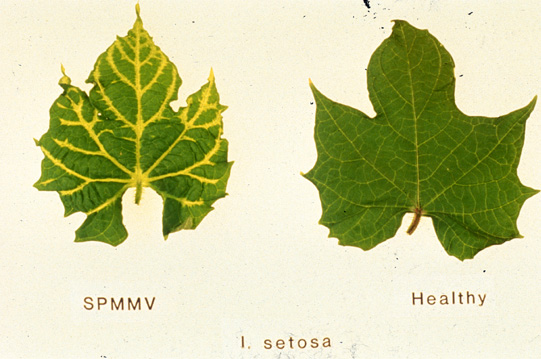|
|
Family |
Potyviriidae |
|
Genus |
Ipomovirus |
The
yield effects of this virus are unknown, but it can reduce the quality of vines
for planting material.
Burundi, Kenya, Tanzania, Uganda, Philippines.
The predominant symptoms associated with SPMMV are mild
leaf mottling and stunting. It induces
distinct veinal chlorosis
in Ipomea setosa. None of these symptoms are diagnostic in the
field and the virus can be latent.
SPMMV is transmitted non-persistently by the whitefly Bemisia
tabaci. It is also perpetuated through planting infected cuttings. SPMMV is
often found in sweetpotato plants also infected with sweetpotato feathery
mottle virus (SPFMV) and sweetpotato chlorotic
stunt virus (SPCSV) but whether there is any
underlying link with either or both of these viruses is unclear.
SPMMV has been shown to spread in East Africa but no
other epidemiological information is available.
SPMMV has been found naturally only in sweetpotato but
can be transmitted experimentally to a wide range of plant species including
many Ipomoea spp but also Beta vulgaris, Chenopodium murale,
Datura stramonium, Gomphrena globosa, Lycopersicon
esculentum, Nicotiana benthamiana, Petunia hybrida and Zinnia
elegans.
Both monoclonal and polyclonal antisera have been
developed against SPMMV allowing sensitive ELISA-based assays to be developed.
The entire genome of SPMMV has been sequenced, allowing nucleic acid techniques
to be utilised. The unusually wide host range and easy sap transmission of SPMMV
allows transmission tests to be useful.
Cultural control
Sanitation and selection by farmers of symptomless
planting material can help achieve control.
Host plant resistance
Some sweetpotato cultivars appear to be immune and others
are tolerant.
Ames, T., Smit, N.E.J.M., Braun, A.R., O’Sullivan, J.N., and Skoglund, L.G.
1996. Sweetpotato: Major pests diseases, and nutritional disorders.
International Potato Center (CIP). Lima, Perú. 152 p.
Brunt, A.A., Crabtree, K., Dallwitz, M.J., Gibbs, A.J., Watson, L. and
Zurcher, E.J. (eds.) (1996 onwards). `Plant Viruses Online: Descriptions and
Lists from the VIDE Database. Version: 20th August 1996.' URL
http://biology.anu.edu.au/Groups/MES/vide/
Colinet, D., Kummert, J., Lepoivre, P. 1998. The
nucleotide sequence and genome organisation of the whitefly-transmitted sweet
potato mild mottle virus: a close relationship with members of the family Potyviridae.
Virus Research 53:187-196.
Hollings, M. and Stone, O. M. 1976. Purification and
properties of sweet potato mild mottle, a whitefly-borne virus from sweet potato
(Ipomoea batatas) in East Africa. Annals of Applied Biology 82:511-528.
Contributed
by: Nicole
Smit and Richard
Gibson
|
Taxonomy
Economic
importance
Geographical
distribution
Symptoms
Biology
and ecology
Host
range
Detection
and inspection
Management
References

Distinct
yellowing of Ipomea setosa leaf veins due to SPMMV (J. Moyer, APS). |

